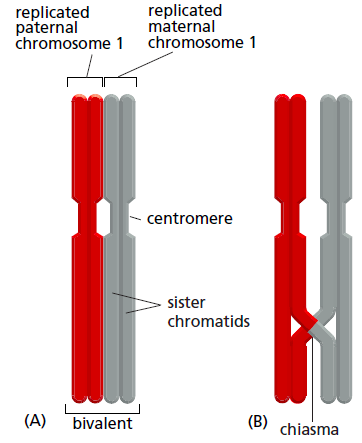Chiasma: Difference between revisions
Jump to navigation
Jump to search
No edit summary |
No edit summary |
||
| Line 1: | Line 1: | ||
Chiasma or crossover refers to the visible point where paired maternal and paternal [[Homologous chromosome|homologous]] [[Homologous chromosomes|chromosomes]] join during [[Meiosis|meiosis ]]1 and then crossover. This [[Recombination|recombination]] occurs when a segment of one paternal [[Chromatid|chromatid]] is replaced by the [[Complementary|complementary]] form of the other maternal [[Chromatid|chromatid]]. <ref>Bruce Alberts, Alexander Johnson, Julian Lewis, Martin Raff, Keith Roberts and Peter Walter, 2008. Molecular biology of the cell. 5th edition. New York: Garland science.</ref> | |||
There are 2 [[Nuclear division|nuclear divisions]] in [[Meiosis|meiosis]], and a chiasma forms in the first division of [[Meiosis|meiosis]] 1. The duplicated [[Homologues|homologs]] align with each other and swap genetic information [[Recombination|(recombination)]]. | There are 2 [[Nuclear division|nuclear divisions]] in [[Meiosis|meiosis]], and a chiasma forms in the first division of [[Meiosis|meiosis]] 1. The duplicated [[Homologues|homologs]] align with each other and swap genetic information [[Recombination|(recombination)]]. | ||
| Line 5: | Line 5: | ||
Crossover happens between 2 non-sister [[Chromatids|chromatids]]. The chiasma can be seen at the point where the [[Homologues|homologs]] join in [[Prophase|prophase]] 1, when the [[Synaptonemal Complex|synaptonemal complex]] disassembles and ''begin to separate. <ref>Bruce Alberts, Alexander Johnson, Julian Lewis, Martin Raff, Keith Roberts and Peter Walter, 2008. Molecular biology of the cell. 5th edition. New York: Garland science.</ref>'' | Crossover happens between 2 non-sister [[Chromatids|chromatids]]. The chiasma can be seen at the point where the [[Homologues|homologs]] join in [[Prophase|prophase]] 1, when the [[Synaptonemal Complex|synaptonemal complex]] disassembles and ''begin to separate. <ref>Bruce Alberts, Alexander Johnson, Julian Lewis, Martin Raff, Keith Roberts and Peter Walter, 2008. Molecular biology of the cell. 5th edition. New York: Garland science.</ref>'' | ||
<br> References: = | === [[Image:Screen Shot 2013-11-27 at 15.23.19.png|Homologous pair of chromosomes showing chiasma]]<br> References: = === | ||
<references /> | <references /> | ||
Revision as of 16:27, 27 November 2013
Chiasma or crossover refers to the visible point where paired maternal and paternal homologous chromosomes join during meiosis 1 and then crossover. This recombination occurs when a segment of one paternal chromatid is replaced by the complementary form of the other maternal chromatid. [1]
There are 2 nuclear divisions in meiosis, and a chiasma forms in the first division of meiosis 1. The duplicated homologs align with each other and swap genetic information (recombination).
Crossover happens between 2 non-sister chromatids. The chiasma can be seen at the point where the homologs join in prophase 1, when the synaptonemal complex disassembles and begin to separate. [2]
- ↑ Bruce Alberts, Alexander Johnson, Julian Lewis, Martin Raff, Keith Roberts and Peter Walter, 2008. Molecular biology of the cell. 5th edition. New York: Garland science.
- ↑ Bruce Alberts, Alexander Johnson, Julian Lewis, Martin Raff, Keith Roberts and Peter Walter, 2008. Molecular biology of the cell. 5th edition. New York: Garland science.
